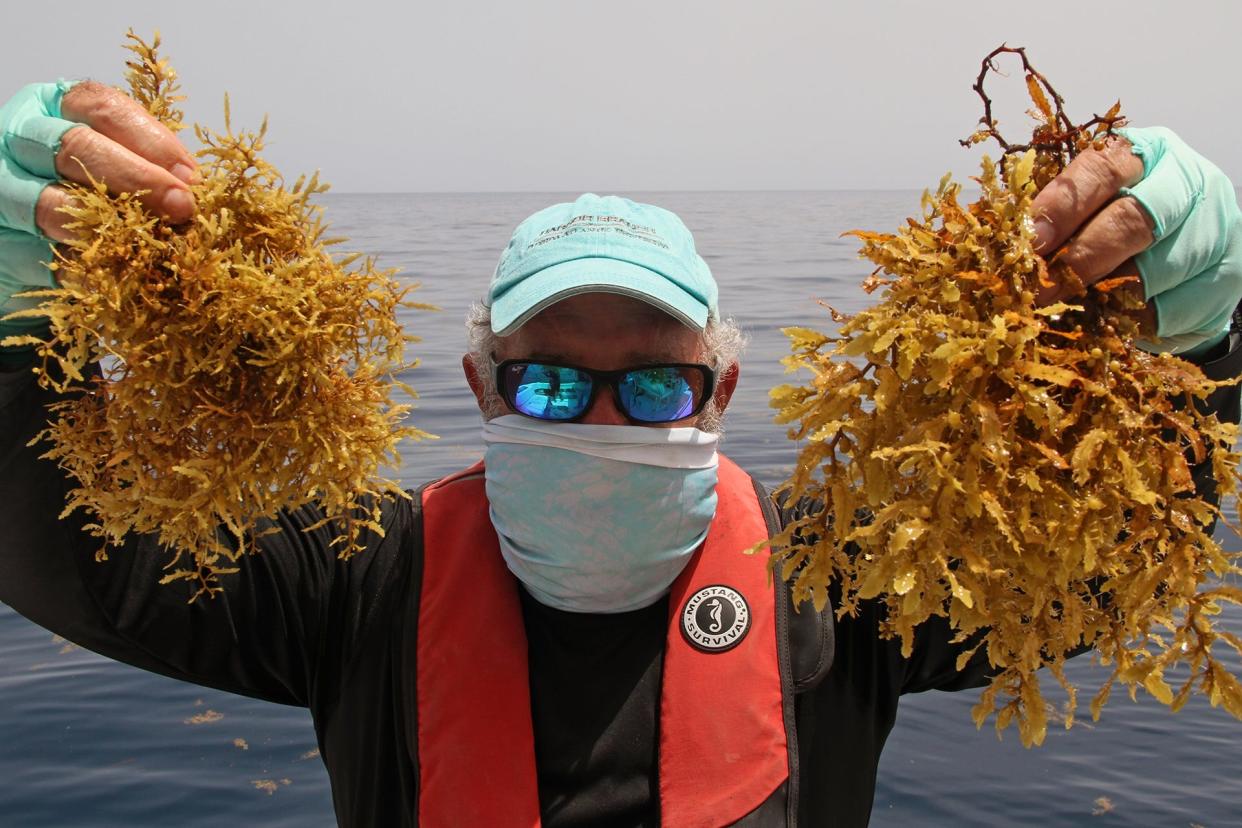Sargassum expected to reach South Florida beaches by late May in potentially 'major' event
The record amount of sargassum reported earlier this year in the Central Atlantic Ocean has yet to assault South Florida beaches, but mats of blooming macroalgae are creeping closer with an unknown plan of attack.
University of South Florida scientists said in early January that nearly 5 million metric tons of seaweed was measured in late 2023, far above the 1 million recorded the previous year at the same time.
But waylaid by stale winds and obscured by clouds, predictions this month have been less clear on the amount and movement of the pelagic flora.
“Unlike most previous years, total sargassum amount decreased from about 9 million metric tons in February to about 6.5 million metric tons in March,” a report from USF’s Optical Oceanography lab stated earlier this month. “The total amount in March was still above the 75% of all previous March months, indicating 2024 could still be a major sargassum year.”
The seafaring bloom of sargassum has traveled west since the beginning of the year and now stretches from south of Puerto Rico to just off the coast of Africa. There has so far been little to no seaweed reported in the Gulf of Mexico and western Caribbean Sea.
Southeast Florida and the Florida Keys will be largely free of the sargassum until late May, this month’s report predicts. The next update will be released near May 1.
Is it safe to swim in sargassum seaweed?
Sargassum is a lifeline for fish nurseries, hungry migratory birds and sea turtle hatchlings seeking shelter in its buoyant saltwater blooms. But in mass quantities, it chokes life from canals, clogs boat propellers and is a killjoy at the beach, piling up several feet deep like a rotting bog emitting hydrogen sulfide as it decomposes.
It's generally safe to swim in but can turn the water an uninviting brown and be uncomfortable when it scratches against your skin.
Why don't they just clean the seaweed off Florida beaches?
Beach managers are constrained to what areas of the beach they can clean during turtle nesting season, which began March 1. Most cities have specially-licensed contractors who use tractors to clear the sargassum at least twice a week, but they are confined to areas below where turtles may nest.
Florida Atlantic University's Harbor Branch Oceanographic Institute won a $1.3 million grant to explore whether harvesting the seaweed before it beaches is possible without harming ocean ecology. Currently, taking sargassum out of the water is prohibited because it is designated as essential habitat for fish and sea turtles.
But it can be harmful for local economies that rely on tourism.
"Sargassum is becoming a devastating mainstay in parts of Florida's coastal communities, particularly in the Florida Keys, where massive blooms continue to recur," said FAU research professor Brian Lapointe in a statement. "Economically, a 'severe' sargassum event could have more than a $20 million impact in just the Keys alone."
Where will the sargassum go in Florida and Palm Beach County?

It's unclear how much seaweed will reach Florida's beaches. But it has shown up in varying degrees and depths during every major growth year, hitching a ride on the loop current to assail the Keys and areas north from Miami to Jacksonville.
Is climate change to blame for all the sargassum?
A 2020 report that included research by the National Oceanic and Atmospheric Administration linked the proliferation of sargassum in the tropical Atlantic Ocean to a 2009-2010 change to the negative phase of the North Atlantic Oscillation, or NAO.
The negative phase of the jet stream meddling NAO means a strong shift in winds to the west and south. Those winds flushed enough sargassum out of the Sargasso Sea, which stretches from around Bermuda east to the central Atlantic, to establish a colony in the tropical Atlantic Ocean.
There, the sargassum got more sunshine and a high dose of nutrients from upwelling ocean waters, according to the report published in the journal Progress in Oceanography in March 2020.
NOAA scientists said earlier this year that it's unknown if climate change led to the severe NAO shift in 2009-2010 but that humans help feed the sargassum bloom with higher nutrient discharges from rivers, such as the Amazon, where deforestation is occurring.
Higher rainfall amounts caused by a warmer climate can also mean more runoff from other rivers that exacerbate the bloom, including the Mississippi River and the Orinoco River in South America.
Kimberly Miller is a veteran journalist for The Palm Beach Post, part of the USA Today Network of Florida. She covers real estate and how growth affects South Florida's environment. Subscribe to The Dirt for a weekly real estate roundup. If you have news tips, please send them to kmiller@pbpost.com. Help support our local journalism, subscribe today.
This article originally appeared on Palm Beach Post: Seaweed on South Florida, Palm Beach County beaches expected in May
